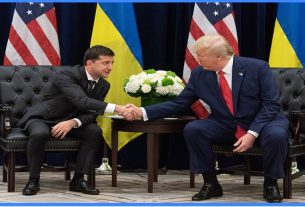|
Getting your Trinity Audio player ready...
|
ProPublica is a nonprofit newsroom that investigates abuses of power. This story was first published as part of ProPublica’s Repatriation Project newsletter, which follows our ongoing investigation into whether U.S. institutions are returning Native American ancestral remains. Sign up to get updates as they publish and learn more about our reporting.
When William Dickson moved to Fulton County, Illinois, from Kentucky in 1833, he purchased a beautiful piece of land overlooking the confluence of the Spoon and Illinois rivers. The federal Indian Removal Act of 1830 had exiled most Native American tribes from the state under the threat of genocide, and Illinois would soon have no tribally held land.
The people of Fulton County, as described an 1879 history of the area, were proud of what they saw as accomplishments of the “Anglo Saxon” race:
“They transformed the wigwams into cities; dotted the knolls with school-houses and churches; replaced the buffalo, deer, elk, and wolf, which had been driven further westward, with domestic animals; erected factories, built railroads, and reared a refined, enlightened and cultured people.”
Still buried throughout much of Fulton County, according to archaeologists’ estimates, were at least 3,000 grave mounds and remnants of villages that belonged to Indigenous people and their ancestors.
So when Dickson prepared his property to plant an orchard in the 1860s, he inadvertently unearthed human remains. His grandson, Thomas, later unearthed more human remains and objects while building his house nearby. Years later, in 1927, Thomas’ son, Don, turned the burial mounds into a public spectacle — and his livelihood.
“I grew up with this knowledge,” Don F. Dickson told an audience of Illinois State Academy of Science members in May 1947. “The burials were in my backyard. I liked those people.”
Dickson, a chiropractor, and his family excavated at least 234 burials and opened the site to the public. While most amateurs, archaeologists and anthropologists of the time fully disinterred and disarticulated human remains during excavations, Dickson chose to leave the burials as he found them in the ground. The novelty of seeing the dead in situ helped make the site a popular Illinois tourist attraction billed as Dickson’s Mound Builders Tomb, or what’s known today as Dickson Mounds Museum.
Inside a canvas tent lay the remains of what Dickson and newspaper reporters believed was an extinct race of people. A 1927 article from one local paper promoted the exhibit under the headline “Excavations in Illinois Reveal Race That Lived and Died Before Indians.” Dickson benefited from the promotion; tens of thousands of people visited the private museum in the late 1920s. By charging 50 cents for admission, the Dickson family made their living.
What visitors learned from the “museum” was the story that the Dicksons wanted to tell. In the remains of two adults placed side by side, their faces turned to face a baby that lay between them, Don Dickson saw a primitive, but loving, family. He speculated about relationships, social hierarchies and the purposes of various possessions. He and his family members served as the tour guides and public interpreters of the site. He rearranged objects to make the burials more dramatic; he removed the mandibles of some people to display them alongside the mandibles of various animals. Many bones and belongings were broken; some were stolen.
The state of Illinois purchased the site from Dickson in 1945 and then hired the Dicksons to run it; Don Dickson continued to interpret the site for the public until his death in 1964.
Credit:
Illinois Digital Archive, Illinois State Library
A few years later, the state built a large, new museum and adopted Dickson’s open-air exhibit as a permanent wing of the facility. Over the years, the burial exhibit saw various interpretations by museum staff, including the addition of audio and multicolored spotlights. Viewmaster reels and postcards were sold in the gift shop.
I learned of the exhibit when I started investigating why the state museum held so many human remains, and I quickly realized that memories of it are not uncommon among a generation of Illinoisans slightly older than I am. An archivist assisting me with research in the Illinois State Archives told me that he was among many Illinois students in the 1970s who had visited the museum on field trips, and he remembered it, simply, as “spooky.”
In 1990, a long movement for Native American rights led to the passage of the Native American Graves Protection and Repatriation Act, a federal law intended to enable tribal nations to reclaim their ancestors, funerary objects and sacred items from institutions.
Staff at the Dickson Mounds Museum and its parent institution, the Illinois State Museum, had been monitoring the bill and others like it for years and had anticipated changes in public sentiment around the display of open graves.
To try to head off controversy, museum leaders decided to close the burial exhibit. Illinois Gov. James R. Thompson had agreed with the museum’s decision. But when news of the exhibit’s planned closure broke, the public outcry and political pressure that ensued forced Thompson to reconsider his decision. At the heart of his dilemma was the question of whether the exhibit was educational or entertainment, and whether the offense it caused to Native Americans outweighed the potential benefits of public education and tourism. Ultimately, Thompson reversed course.
“This never has been treated as a carnival sideshow,” Thompson said. “It is an educational exhibit that respects the lives of people who made a civilization here hundreds of years ago. It will remain so.”
Among Thompson’s most vocal opponents was Michael Haney, an activist of Seminole and Sioux heritage. Haney had helped gather crowds of protestors at the museum and had responded to the governor’s decision to keep the exhibit open by calling it racist. But in addition to making many pointed public comments, which included referring to Fulton County residents as “country bumpkins,” he expressed the deep hurt caused by the Dicksons and those who supported keeping the exhibit open in a way that continues to resonate:
“If you want to know about Indians, ask living Indians,” Haney said at a public hearing in 1990. “Don’t desecrate our graves.”
Credit:
Illinois Digital Archive, Illinois State Library
For perhaps the first time, some local residents and others paying attention to the issue were forced to confront the notion that, by advocating to keep the exhibit open, they were complicit in the erasure of Indigenous people from the story the museum was telling about them.
The controversy lasted for more than two years.
The exhibit eventually closed in 1992. Contractors installed cedar flooring over the open graves to shield them from public view. Museum officials today say that no one has seen the graves in 30 years.
At ProPublica, my colleagues and I have spent the last 18 months trying to understand why so many of the nation’s top museums and universities still have thousands of human remains in their collections even though the law to push for repatriation passed more than 30 years ago. The Illinois State Museum and Dickson Mounds Museum, for example, together hold the remains of more than 7,000 Native Americans.
But a new generation of museum leadership sees an opportunity to rewrite the story the Dicksons wanted visitors to learn, and returning remains to tribal nations is part of that. Dickson Mounds Museum is now led by a citizen of the Peoria Tribe of Indians of Oklahoma, whose members are descendents of more than a dozen tribes that were forcibly removed from the state in the 1700s and 1800s.
“My ancestors put me here,” said Logan Pappenfort, interim director of Dickson Mounds Museum. “They came from Illinois, and it’s my responsibility to do everything I can to get them where they’re supposed to be again.”




